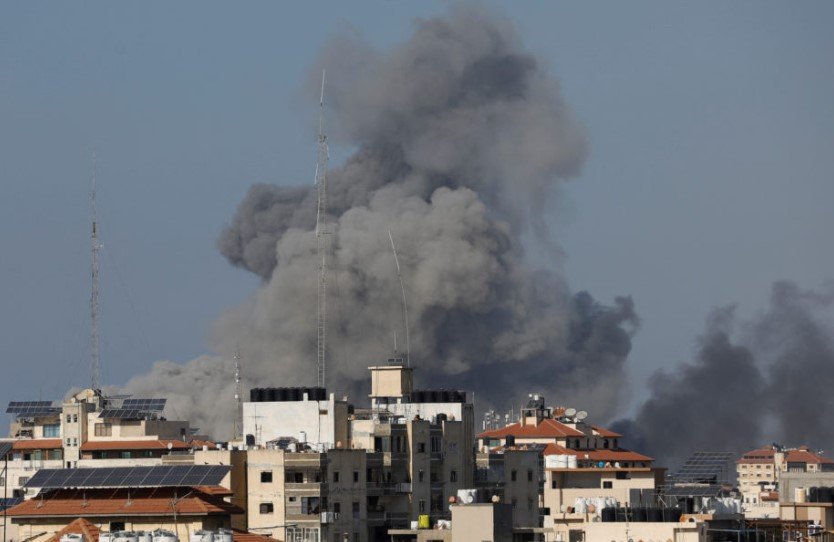Israel has stepped up its air strikes and artillery fire on Gaza City, with Defense Minister Israel Katz declaring that Gaza is burning. This comes amid reports of a possible ground push into the city, as US Secretary of State Marco Rubio pushes for a quick ceasefire deal during his Middle East visit on September 16, 2025.
Heavy Strikes Rock Gaza City
Local reports describe non stop explosions lighting up the night sky over Gaza City. Residents say Israeli jets and guns have hit homes, schools, and mosques, leaving many people trapped under rubble.
Palestinian health officials report dozens killed and hundreds hurt in the latest wave of attacks. The bombardment started late Monday and continued into Tuesday morning, forcing thousands to flee south.
The Israeli military says it targets Hamas sites and tunnels. Yet civilians bear the brunt, with entire neighborhoods flattened. One strike hit a crowded market area, killing at least 14 from one family, according to witnesses.
Aid groups warn of a growing crisis, as hospitals overflow with the wounded. Power cuts and shortages of medicine make things worse for those still in the city.
Evacuation Orders Spark Mass Flight
Israel ordered all residents of Gaza City to leave for safer zones in the south. The military estimates about 250,000 people have already fled, but hundreds of thousands remain.

Many say they stay because travel costs too much or they fear attacks in the south. Some tried to go but found no space for tents and came back.
Here are key reasons people give for not leaving:
- High transport fees amid poverty.
- Past strikes in so called safe areas.
- Family members too sick or old to move.
- Shortage of food and water in evacuation spots.
The United Nations reports nearly one million people at risk in the city. Roads south are jammed with families carrying what they can on foot or in carts.
Defense Minister’s Stark Warning
Israel Katz posted on social media early Tuesday, saying Gaza is burning and Israel will not stop until the job is done. He vowed to hit Hamas hard with an iron fist.
This tough talk follows Prime Minister Benjamin Netanyahu’s meeting with Rubio. The US official stressed unwavering support for Israel but urged a fast end to the fighting.
Katz’s words echo past conflicts, where Israel aimed to destroy militant groups. Analysts say this signals a long offensive ahead.
Hostage families in Israel protest outside Netanyahu’s home. They fear the attacks put their loved ones in more danger. About 48 hostages are still believed held in Gaza.
US Diplomat Pushes for Ceasefire
Marco Rubio arrived in Jerusalem on Monday and met top Israeli leaders. He assured them of full US backing but warned time is short for a deal.
Rubio then headed to Qatar, a key mediator with Hamas. Arab leaders there condemned recent Israeli actions, including a strike on Doha.
The US wants Hamas to give up arms for peace. Rubio told reporters that talks must wrap up soon to avoid more deaths.
This visit ties into broader efforts to calm the region. Recent events include strikes in Lebanon and Syria, raising fears of wider war.
| Key Players in the Conflict | Role | Recent Actions |
|---|---|---|
| Israel Defense Forces | Military | Launched air strikes and possible ground ops in Gaza City |
| Hamas | Militant group | Targeted by Israel; holds hostages |
| Marco Rubio | US Secretary of State | Visited Israel and Qatar for talks |
| Benjamin Netanyahu | Israeli Prime Minister | Approved escalation after US meeting |
| Israel Katz | Defense Minister | Declared Gaza is burning; vowed no retreat |
Impact on Civilians and Aid Efforts
The fighting has wrecked daily life in Gaza. Schools close, markets empty, and families huddle in basements during strikes.
International aid faces blocks at borders. Trucks with food and medicine wait days to enter, while needs skyrocket.
One report counts over 1.3 million people still in northern Gaza. Many live in refugee camps hit by bombs.
Women and children make up most casualties, per health data. Stories emerge of kids separated from parents in the chaos.
Global Reactions and Next Steps
World leaders call for restraint. The UN urges an immediate halt to protect civilians.
Protests erupt in cities worldwide, demanding peace. Some governments pledge more aid to Gaza.
Israel says it acts in self defense after Hamas attacks. Hamas vows to fight on.
As tensions rise, eyes turn to Rubio’s talks in Qatar. A breakthrough could save lives, but failure might lead to more bloodshed.
What do you think about the latest developments? Share your thoughts in the comments and spread the word to raise awareness.
